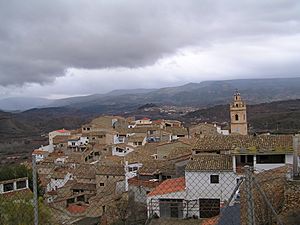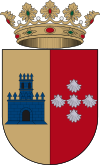Zarra, Spain facts for kids
Quick facts for kids
Zarra
|
|||
|---|---|---|---|
 |
|||
|
|||
| Country | |||
| Autonomous community | |||
| Province | Valencia | ||
| Comarca | Valle de Ayora Cofrentes | ||
| Judicial district | Requena | ||
| Area | |||
| • Total | 49.72 km2 (19.20 sq mi) | ||
| Elevation | 605 m (1,985 ft) | ||
| Population
(2022)
|
|||
| • Total | 615 | ||
| • Density | 12.369/km2 (32.036/sq mi) | ||
| Demonym(s) | Zarrino/a | ||
| Time zone | UTC+1 (CET) | ||
| • Summer (DST) | UTC+2 (CEST) | ||
| Postal code |
46621
|
||
| Official language(s) | Spanish | ||
Zarra is a small town in the Valencian Community, Spain. It is the smallest of seven villages in the area known as Valle de Ayora Cofrentes. This area is part of the Valencia province.
A Look at Zarra's History
The name "Zarra" comes from an old language called Iberian. It means "the old" or "ancient."
The village has a church that was built in the 1700s. There is also a tall clock tower that stands by itself, built in 1880. Many of the homes in Zarra are very old, some dating back 400 years!
Long ago, during the time of the Moors in Spain, a castle was built here. Sadly, no parts of the castle are left today. We don't even know exactly where it stood. Spanish forces took back the village in 1249. It became part of the Valencia region in 1281. The Zarra we see today started to grow around the year 1600.
Zarra Today
Today, Zarra is home to about 615 people. The number of people living here has grown recently. This is mostly because people from Britain have moved to the village and the areas nearby.
Fun Festivals in Zarra
Zarra is famous for its three yearly festivals! These celebrations kick off the festival season in the valley.
- The first festival is for San Anton in January.
- Next is the festival for Santa Ana in July.
- The biggest festival is the "bull" fiesta, which happens in late July or August.
What People Do for Work
The main job in Zarra is agriculture. This means farming! People mostly grow cherries and olives here. These crops are very important to the village's economy.




